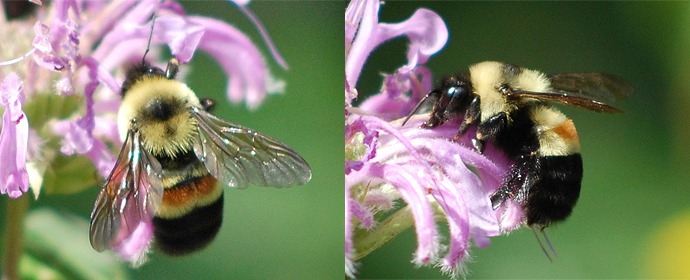There is no sign of the rusty-patched bumble bee which used to be one of the most common bees in southern Ontario and Quebec but is now one of the rarest. In fact, the rusty-patched bumble bee, known to scientists as Bombus affinis, is the first bee in North America to be officially declared an endangered species. Federal Environment Minister Peter Kent added the bee to Canada's list this summer and federal wildlife advisers warn the bee appears to be on the brink of extinction. Few people even realized the bee was in trouble until Sheila Colla, a PhD student at York University, documented the drastic decline. "It shows we are really not paying attention, which is kind of scary," she says. Bees may not be everyone's favourite bugs - onlookers tend to take a few steps back when they realize Colla is using her net to catch bees, not butterflies - but they are key eco-logical players. They're essential for production of fruit and seeds that feed everything from bears to birds. They also pollinate crops that produce one-third of the human food supply. "Yet most people consider them to be an irritant," says York biologist Laurence Packer, keeper of Canada's biggest bee collection.
The cabinets in his lab contain thousands of bees from as far north as Ellesmere Island and as far south as Patagonia. Some are the size of aphids, others big as small birds. The only species the York team avoids is the honey bee, which gets plenty of attention from other researchers. Packer and his graduate students focus on wild bees - about 19,500 species in the world, 808 of them in Canada. They say the insects deserve more attention and appreciation, in part because they are such sensitive environmental indicators. "They're like the canary in the coal mine," says Packer. And when a common species such as the rusty-patched bumble bee disappears, he says, "it's a warning signal that things are going wrong in the great outdoors." Many bees across Canada are in decline. The western bumble bee has vanished from most of its range in British Columbia and the United States in the last decade, and Colla says that about half the 21 bumble bee species in Eastern Canada have seen significant population drops in recent decades. But the loss of the rusty-patched bumble bee has been most dramatic. The bee with a distinct orange patch on its abdomen used to forage for pollen and nectar on milkweeds, sunflowers, clovers, berry and fruit blossoms across southern Ontario and Quebec. Colla became intrigued in 2004 when she came across a survey from the 1970s of 3,632 bees from southern Ontario. Bombus affinis was the fourth most common of 14 species. She repeated the survey and found not a single rusty-patched bumble bee. Colla expanded the search to other areas of Ontario and the U.S. She did eventually find two in Pinery Provincial Park in south-west Ontario: one in 2005, the other in 2009. The bees are now skewered on straight pins and stored in a glass-covered case in the York lab. Only one other rusty-patched bee has been spotted in Canada in the last decade. It, too, was seen in Pinery Park in 2009. The search for the bee continues this summer. Colla and assistant Kristin Wazbinski are visiting dozens of sites where the Bombus affinis was historically found in Ontario for a project sponsored by Wildlife Preservation Canada, a non-profit group. Colla and Wazbinski are catching plenty of bumble bees but not a single rusty-patched bumble bee. The situation is only slightly better in the U.S., with researchers finding a few of the bees in Wisconsin and Minnesota this summer. Scientists say the loss of the bee may be impacting food chains and ecosystems. Bom-bus affinis was known to visit everything from raspberries and lilacs in the spring to goldenrod and asters in the fall. But they say it is difficult to pin down effects. "I worry about the spring ephemeral flowers," says Colla, noting the rusty-patched bumble bee was one of the few insects around to pollinate trilliums, trout lilies and spring lilies. In his book Keeping the Bees, Packer describes how bees around the world are at risk from habitat loss, pesticide use, disease and other factors. Because of the integral role the insects play in the ecology of the planet, he warns "we may be at risk as well. It's the small things that run the world."
Read more: http://www.vancouversun.com/technology/Decline+bumble+populations+baffl…

- Login om te reageren
